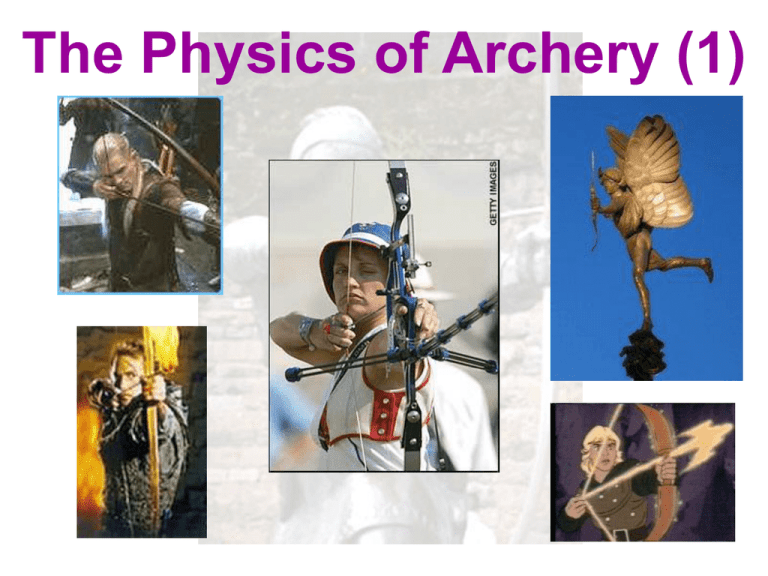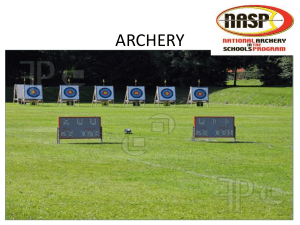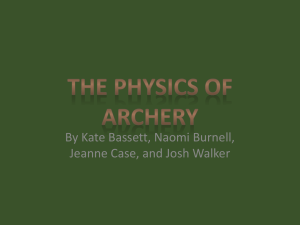The Physics of Archery
advertisement

The Physics of Archery (1) Objectives To Understand the Basic Physical Principles of Archery Through Identifying: • Energy Transfers • Energy Storage • Trajectories Bow Anatomy Riser/Handle Limbs Grip String Energy Transfer Procedure 1. Hold up bow and put arrow on string 2. Place fingers on string and pull string back 3. Anchor string and hand under the chin 4. Take aim 5. Release the string 6. Arrow hits target (hopefully!!!) TASK 1: Identify the stages in this energy transfer. Draw a Sankey diagram to show this. Energy Transfer (solution) Procedure Main Energy transfer 1. Hold up bow and put arrow on string Chemical in arm to kinetic in arm, string & limbs 2. Place fingers on string and pull string back Kinetic in arm & string to elastic potential in limbs 3. Anchor string and hand under the chin 4. Take aim Elastic potential in limbs to kinetic in string, limbs and arrow 5. Release the string 6. Arrow hits target (hopefully!!!) Kinetic in arrow and sound in limbs Kinetic in arrow to heat and sound in target Energy Transfer (solution) Sankey Diagram Showing Losses Kinetic in string; sound in limbs and string; heat in limbs Chemical in arm Kinetic in arm, string, & limbs Elastic potential in limbs Kinetic in arrow Heat and sound in target Heat and sound of arrow in flight Sound in limbs; heat in arms; heat in limbs & string Energy Storage Draw force (N) 165 Graph to show draw force against draw length Work Done = Force (constant) X Displacement in direction of force Work Done = area under the line 0 70 Draw length (cm) Task 2: Calculate the energy stored in 165N bow drawn to 70cm Energy Storage Graph to show force against distance Work Done = Force X Displacement in direction of force Force (N) 400 Consider an action that consists of two parts • pushing a 20 kg block along for 20 cm 200 • pushing 2 20kg blocks along for 15 cm 0 20 35 Distance (cm) Area of rectangle = height X length Add the shaded boxes together! Task 2: Calculate the energy stored in 165N bow drawn to 70cm Energy Storage (solution) Draw force (N) 165 Graph to show draw force against draw length Force = 165 N Distance = 70cm Work Done = ½ 165 * 0.7 0 70 Draw length (cm) Work Done = 57.75 J Arrow Energy Nock Shaft Fletchings Point Kinetic energy = ½ mass X velocity2 Task 3: Calculate the velocity of the arrow (mass 25g), assuming efficiency of energy transfer of limbs to arrow 0.70 Arrow Energy (solution) Nock Shaft Fletchings Point Mass = 25g Kinetic energy = 0.70 X work donebow Work done = 57.75J Kinetic energy = ½ mass X velocity2 Efficiency = 0.7 Therefore velocity = √(2 X kinetic energy/mass) Velocity = √(2 X 40.425 / 0.025) = √ 3234 = 56.87 ms-1 Trajectories Parabolic shape of arrow flight Can consider the vertical and horizontal components of the flight separately. Think SOH CAH TOA!!! height vh = v cos θ vv = v sin θ v = u + at v=d/t v2 = u2 + 2as t distance height t θ distance Task 4: Split the components of the arrow velocity up and calculate the max range and the max height at that range . Assume air resistance is negligible. Trajectories (solution) Split the component into vertical & horizontal: v = 56.87 ms-1 for maximum range, θ = 45O vh = v cos θ = 56.87 sin 45O = 40.21 ms-1 vv = v sin θ = 56.87 cos 45O = 40.21 ms-1 Taking vertical component first up to highest point: u = 40.21 ms-1 a = g = -9.81 ms-2 v2 = u2 + 2as 0 = 40.212 – 2 X 9.81 X s Therefore s = 40.212 / (2 X 9.81) Maximum height = 82.4m height θ distance Trajectories (solution) v = u + atup 0 = 40.21 - 9.81 X tup Therefore tup = 40.21 / 9.81 = 4.10 s Therefore tflight = 8.20 s Taking the horizontal component: velocity = 40.21 ms-1 time = 8.20 s velocity = distance / time Therefore distance = velocity X time Max range = 40.21 X 8.20 = 329.7 m height θ distance Can humans dodge arrows? The human target would need to move outside of the area as shown Assume the archer is very accurate. Fastest human travels at 10ms-1 3m Time for the human to realise the arrow is incoming = 1 second 0.5 m Human response time 0.25 seconds Target Top view Task 5: What is the minimum distance the target needs to be before they can successfully dodge an arrow? Can humans dodge arrows? Time taken for human target to dodge: d2 = 32 + 0.52 d = 3.04 m tmove = 3.04 / 10 = 0.304 s tdodge = trealise + treact + tmove = 1 + 0.25 + 0.304 = 1.554 s So we calculate the distance at which tflight = 1.554s tup = tflight / 2 = 0.777 s v = u + atup u = v – atup = 0 + (9.81 X 0.777) = 7.62 ms-1 = vv vv = v sin θ v = 56.87 ms-1 sin θ = vv / v = 7.62 / 56.87 = 0.13 therefore θ = 7.7 0 vh = v cos θ = 56.87 cos 7.7 = 56.36 ms-1 vh = d / tflight s = vh X tflight = 56.36 X 1.554 = 87.58 m So the human target would need to be at least 87.58 m away from the archer in order to dodge the arrow. Safety Information Before taking part in archery you need to understand certain safety rules!!! • Do not put the arrow on the string until you are standing on the shooting line • Do not distract anyone who is shooting • Once on the string, only ever point the arrows in the direction of the targets • If you are not shooting stay well behind the shooting line • If you see any possible hazard or danger (e.g. someone is walking behind the targets) then shout the word “FAST”. If you hear the word “FAST”, then do not shoot any arrows under any circumstances. • One whistle means shooting can start, two whistles means that you can collect your arrows from the target • Don’t draw and then release the bow without an arrow on it (this is called a “dry fire”) as this can damage the bows FOLLOW THE INSTRUCTIONS OF THE COACH AT ALL TIMES The Physics of Archery (2) Photos from the Archery Have A Go Here!!! Objectives To Reinforce our Understanding of the Basic Principles of Archery by: • Looking at a real life application at the Battle of Agincourt • Creating a poster and presenting on an area of what has been learnt Different Types of Bow Longbow Crossbow Recurve Compound The Battle of Agincourt 1415 Country: England France # of Men: 6000 men 20,000-30,000 men # of Archers: 5000 archers 8000 archers Style of Bow: Using longbows Using crossbows Mass an Arrow: 50g 75g Poundage: 150lbs @ 28” 300lbs @ 16” Release rate: 12 arrows/min/archer 4 arrows/min/archer Efficiency: 0.70 0.60 Convert the units from imperial to metric Calculate the energy stored in each type of bow Calculate the speed of the arrow on release Calculate the maximum range Remember to note down any assumptions you have made Conversion Rates & Useful Formulae 1 lb = 0.45 kg 1 inch (“) = 0.025 m Area of triangle = ½(base X height) v = u + at s = ½ (v + u)t k.e. = ½ mv2 v=d/t English Longbow Range Energy stored in bow: Conversion: 150lb = 9.81 X 0.45 X 150 = 662.2 N 28” = 0.7m Work done = ½ (662.2 X 0.7) = 231.8J Velocity of arrow on release: k.e. = ½ m v2 v2 = k.e. / ½ m = 0.7 X 231 / ½ 0.05 = 6489.3 v = 80.6 ms-1 Splitting the vertical and horizontal components: vv = v sin θ vh = v cos θ vv = 80.6 sin 450 = 57 ms-1 vh = 80.6 cos 450 = 57ms-1 English Longbow Range Time taken to reach highest point: v = u + atup tup = (v – u) / a = 57 / 9.81 = 5.81 s tflight = 11.62 s Maximum range of longbow: vh = d / tflight d = vh X tflight = 57 X 11.62 = 662.4m French Crossbow Range Energy stored in bow: Conversion: 300lb = 9.81 X 0.45 X 300 = 1324.35 N 16” = 0.4m Work done = ½ (1324.35 X 0.4) = 264.9J Velocity of arrow on release: k.e. = ½ m v2 v2 = k.e. / ½ m = 0.6 X 264.9 / ½ 0.075 = 4237.9 v = 65.1 ms-1 Splitting the vertical and horizontal components: vv = v sin θ vh = v cos θ vv = 65.1 sin 450 = 46 ms-1 vh = 65.1 cos 450 = 46ms-1 French Crossbow Range Time taken to reach highest point: v = u + atup tup = (v – u) / a = 46 / 9.81 = 4.69 s tflight = 9.38 s Maximum range of crossbow: vh = d / tflight d = vh X tflight = 46 X 9.38 = 431.5 m Why did the English Win? Terrain Timing Sited in a narrowing valley Hours waiting Muddy rainy conditions Frequency of arrows Position Class/Tradition/Organisation English archers on flanks French archers pushed backwards by nobility French multiple lines, archers behind front line French disorganised Equipment Protection Longer range Armour Greater frequency Pikes in ground Why did the English Win? Poster & Presentation Design a Poster. Presentations to be given at Friday’s lesson. Split into groups – each responsible for one area. Poster options: Physical A1 poster. PowerPoint poster. Web page poster. 1. Intro page 2. Equipment Anatomy & How to Shoot 3. Energy Transfers in Archery 4. Trajectories 5. The Battle of Agincourt








